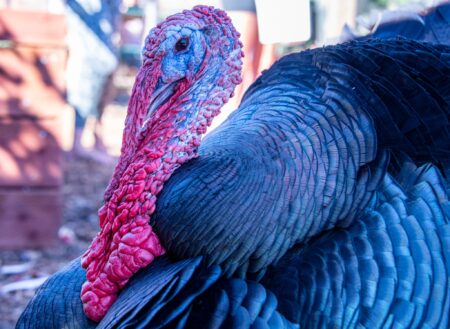All Turkeys Go to Heaven
Brendan Praniewicz
__________
His name was Nev.
Short for Nebuchadnevah. An egregious typo, meant to be named the biblical
Nebuchadnezzar, but a suitable name for a 55-pound turkey, who I believed would “nevah” die.
The first time I saw Nev was at a feed shop in rural San Diego. The dusty scent of hay
and alfalfa hung in the air. With the intentions of purchasing chickens, I wandered through the
store. A baby turkey peered through a metal cage, stretched his long neck between bars, and
gently pecked my hand. Then he squeezed out this chirp that sounded like water, splashing into a basin.
I lifted the bird from the cage, cupped my hands around his tiny, warm body, and fell in
love.
Buying a turkey warrants an immediate response from friends and neighbors. A question
never asked when you purchase a pug or guinea pig—“When are you going to eat him?” I had
no desire to feast on my pet.
For the first few months, I kept Nev in a dog kennel, wrapped in chicken wire. He had
twelve room mates, all baby Golden-Laced Wyandotte chicks. A heat lamp hung from the
ceiling and cast the birds in a red glow and warmed them through the night. My German
Shepherd inspected the garage, patrolling every half hour to ensure their safety. The hens, too
young and small to roam the yard, where coyotes and red-tailed hawks lurked.
Turkeys, like childhood celebrities, never age well. When little, they are adorable, but
months down the line, extreme puberty occurs. Turkeys are the Macaulay Culkins of the animal
kingdom.
Nev grew into the size of wheelbarrow. Blue and red bumps emerged from his soft-
feathered head, and a worm-like snood dangled from his beak. His cute chirp evolved into a
thundering gobble, annoying neighbors and frightening anyone who approached.
The turkey followed me around the yard, stomping his giant feet as if he wore oversized
flip flops. Ascending hills, he huffed and wheezed like he’d just smoked a carton of cigarettes.
Even on the edge of heart attack, he trailed behind me everywhere.
Whenever I stopped walking, he’d puff his chest, fan his tail feathers, and bump into my
leg. Turkeys have a tremendous sense of confidence, as if this action would send me ten feet
back or make me spontaneously combust. He never tired of this game.
Despite his bullish ways, he always entertained. His eating habits were hilarious. He’d
tilt his heads back and practically gargle food pellets, spilling them everywhere. Nev had a
sweet side as well. When I’d pet his bumpy crown, he’d peer at me with golden eyes, expressing gratitude.
One day Nev decided to play turkey games with my German Shepherd. The canine, 140
pounds, generally patient and well-tempered, had enough of bully butterball.
While washing dishes, I overheard the commotion in the yard. A couple of gobbles, a
few warning barks, and wings flapping in panic.
I ran outside. Feathers coated the dog’s mouth, and others, speckled with blood,
helicoptered in the air. Nev, still intact, stood wheezing. A pocket-sized wound hung from his
chest.
Did I mention I loved that bird?
Within seconds, I corralled Nev toward my four-door Chevy Prism. Gathering the bird in
my arms, I shoveled him in the backseat.
Racing down the street with my hazard lights on, I probably looked insane. The band,
the Killers, pumped from speakers. In the back of my car, this creature, the size of a California
condor, spread his enormous wings, smacking them on windows, and gobbled with fury.
When I pulled up to stoplights, people in lifted trucks, stared down in jaw-drop wonder
and pointed fingers. When the light turned green, I revved the engine and gunned the car toward the closest pet emergency hospital.
It’s not easy guiding a turkey into a vet’s office. A Looney Tunes scenario with
predators abound—dogs lunging on leashes, and cats, in attack mode, ready to pounce out of
carriers.
The most disconcerting part—the judgment—skeptical faces in every direction, seeming
to ask—“Why don’t you just eat him?”
The front desk receptionist glanced down and asked, “What do we have here?”
“My dog bit my turkey, and I think he needs stitches.”
“Let’s get him to a back room,” she said with surrounding killers in a frenzy.
Vet techs gathered around the feathered curiosity. Bearing grins, they seemed elated that
someone brought in a species they’d never operated on and probably never would again.
A young, muscular assistant, struggled lifting Nev in his arms, and he teeter tottered as he
lugged the bird down the hallway.
In the lobby, I waited in trepidation. It’s a risky venture, bringing a turkey to a vet—were
they going to heal him or eat him? I kept my nose on alert for any scents of garlic or rosemary.
But Nev’s constant gobbling, echoing down the hallway, assured me of his safety.
Moments later a vet returned with a clipboard. Her face held concern. “He’s badly
wounded. In order to stitch him, we need to anesthetize him. It’s going to be 1500 dollars.”
I shoved my hands in my pockets and sighed. With Christmas approaching and living on
a teacher’s wage, I didn’t have the money.
“I’m sorry, but I can’t afford that.”
I prepared myself to say a final goodbye to my friend.
“Just a minute,” she pursed her lips. “Let me see what we can do.”
Gobbles and negotiations ensued.
She finally returned and said, “Because this is a special case.” She leaned forward and
whispered, “We can write off some of your bill for training purposes. Can you afford 500
dollars?”
“Let’s do it,” I smiled in relief.
An hour later, out stomped my clumsy, drunk turkey, who glared at me with a confused,
angry expression that said—I don’t know what happened, but get me out of here.
I thanked the vets, wrapped the bird in my arms, and carried him to my car. Night had
fallen, and Nev, wrapped in blankets, dozed off in the backseat.
Nev lived another two years.
Sometimes he’d attract a gang of wild turkeys into the yard. They’d play like children,
kicking up dead oak leaves as they’d hunt for crickets and grubs. Nev didn’t have the ability to
fly away and roost with them—his body wasn’t designed for flight. And he couldn’t breed with
the wild hens because domesticated turkeys aren’t engineered to reproduce naturally.
Despite his handicaps, Nev adored his adopted brothers and sisters. Together they’d lie
in cool summer grass until the creamy sun descended into canyons, when his family departed to the safety of tree canopies.
One night a band of coyotes killed Nev.
With great sorrow, I buried him beside a blood orange tree.
Nev lived five years longer than most turkeys. Humans are born to live, but these birds
are bred to die.
If you take a moment to understand them, turkeys offer so much endearment and joy.
Their clownish antics and unwavering companionship, continue to warm hearts long after they’re gone.
I miss him.
__________

Brendan Praniewicz‘s pet turkey, Nev.
__________
Brendan Praniewicz earned his MFA in creative writing from San Diego State in 2007 and has subsequently taught creative writing at San Diego colleges. He has had poetry published in From Whispers to Roars, Tiny Seed Journal, That Literary Review, and The Dallas Review. In addition, he received second place in a first-chapters competition in the Seven Hills Review Chapter Competition in 2019. He won first place in The Rilla Askew Short Fiction Contest in 2020. He was a 2023 Pushcart Nominee for poetry. He can be found on Facebook (Brendan Praniewicz), Instagram (@praniewicz), and his website is brendan-praniewicz.com
__________

🢠 Back
To learn more about submitting your work to Boudin or applying to McNeese State University’s Creative Writing MFA program, please visit Submissions for details.
Posted in Second Annual Pet Writing Contest and tagged in #boudin, #fiction, Fiction
